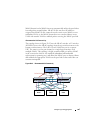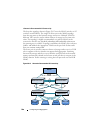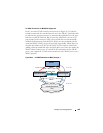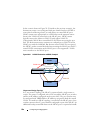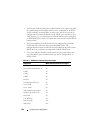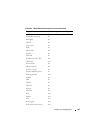
954 Configuring Link Aggregation
such as ECMP and redundant router pairs, will allow a L3 routed network to
utilize bandwidth efficiently. L3 routing is capable of routing packets around
failed links and failed routers.
Spanning tree (and LACP) PDUs are proxied from the secondary MLAG peer
to the MLAG primary switch. This implies that at least two spanning tree
roots will exist in the MLAG network. Spanning tree on the secondary switch
shows as the root bridge because, in a properly configured network, it will
have no ports attached. In an improperly configured network, one in which
orphan ports and orphan port VLANs are configured on one or both MLAG
switches, three root bridges may appear in the network: the root bridge for the
MLAG member ports/VLANs on the primary switch, the port-less root bridge
on the secondary switch, and the root bridge for the orphan ports/VLANs that
are not part of the MLAG. Careful planning may be required when
configuring the network to ensure that orphan ports are isolated on the
MLAG peers, and segregating the MLAG VLANs from the non-MLAG
VLANs to not cross the peer link can reduce the number of root bridges in the
network to two.
The peer link requires a native VLAN to be configured. This is a limitation of
the peer-link keep alive protocol.
On primary switch failover, the secondary switch flushes the FDB MAC
addresses and uses its own MAC address in spanning tree BPDUs and in the
LACP actor ID. This will cause LACP to rebuild the link aggregation group
followed by spanning tree reconvergence.
MLAG-supported protocols are active only on the MLAG primary switch.
The protocols are proxied from the secondary peer switch to the primary
switch. The primary switch receives state information from the secondary
peer switch and programs the secondary peer hardware. It does not send
protocol state information to the secondary peer. This leads to a number of
seemingly inconsistent behaviors if these facts are ignored:
• MLAG port-channel state is maintained on the primary peer only. The
MLAG secondary peer has accurate state for the member links, but not for
an MLAG port-channel. The operator can shut down a MLAG port-
channel only from the primary MLAG peer.
• Shutting down a MLAG port-channel on the primary peer shuts down the
port-channel on both the primary and secondary MLAG peers.




